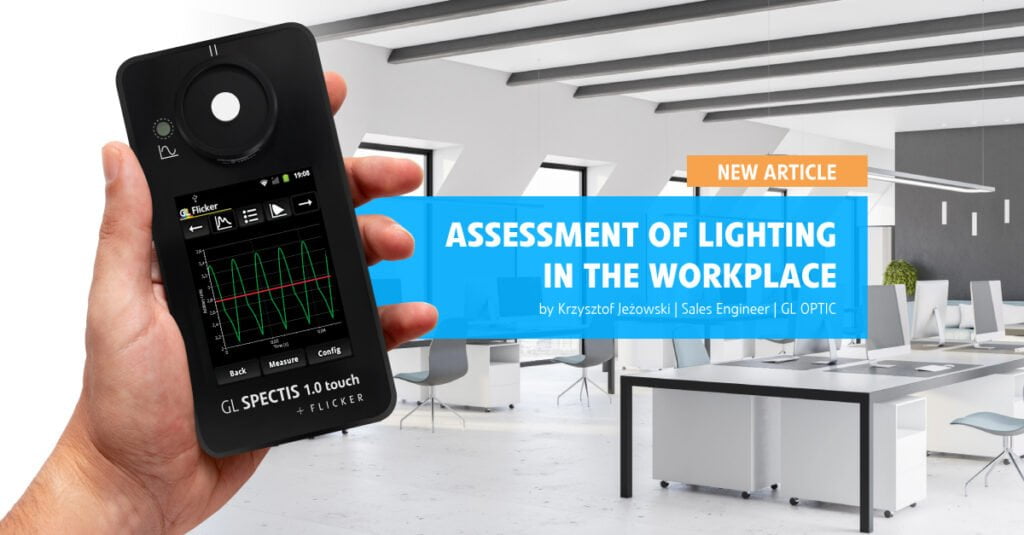Use of GL SPECTIS 1.0 Touch + Flicker in accordance with EN 12464:2022 Light and lighting - Lighting of workplaces - Part 1: Indoor workplaces
Lighting plays a key role in shaping the wellbeing and productivity of employees. Adherence to standards such as EN 12464 ensures that the quality of lighting is not just a question of brightness, but also includes factors such as colour rendering index (CRI), flicker, illuminance and illuminance distribution.
It is worth measuring these parameters not only in laboratory conditions by manufacturer, but also after the useful life of the lighting to check whether the values adopted by the designer in the design of lighting are actually maintained (periodic measurements). This applies to general lighting, as well as to emergency and evacuation lighting, which contributes to safety in the event of an emergency.
Measurement of illuminance
Illuminance measurement in lux is one of the key elements in the verification of workplace lighting.The amount and distribution of illuminance affects how users perceive their environment, influences mood and concentration. Which translates into efficiency and accuracy and is essential for tasks that require precision and attention to detail. The GL SPECTIS 1.0 Touch + Flicker portable spectrometer is able to measure illuminance levels, ensuring that they meet the specific requirements for different work areas, in accordance with EN 12464-1:2021.
The overall illuminance level in the room, not only on the desk should be also in mind. The thing is not only about to light up workplaces, but also provide a general level of visibility in the room to comfortably see other people and objects in the environment.
Colour assessment with GL SPECTIS 1.0 Touch
Section 5.7 of EN 12464:2021 focuses on colour aspects, including CRI. By measuring the light spectrum, the GL SPECTIS 1.0 Touch + Flicker spectrometer, compared to a normal photometer, allows the calculation of the colour rendering index Ra and colour temperature, helping to verify the design. Colour rendering, which is crucial for tasks that require precise colour distinction, e.g. medical practices. Colour temperature [Tcp], together with the colour rendering index, has a significant impact on the aesthetics of a room, including the comfort of the space in use.
Assessing flicker and strobe effects for optimal health
Flicker and stroboscopic effects are more than just a nuisance, they can have a significant impact on health and well-being. The EN 12464 standard dedicates sections 5.8.2 and 5.8.3 to these issues. GL SPECTIS 1.0 Touch + Flicker perfectly detects these effects allowing the assessment of both the short-term flicker indicator PstLM (according to IEC TR 61547-1:2020) and the SVM Stroboscopic Visibility Measure (according to IEC TR 63158:2018), ensuring a flicker-free and comfortable working environment.
These are particularly important parameters in LED lighting because, unlike incandescent light sources, the light emitting diode, which is a semiconductor, reacts immediately to changing power supply conditions. For this reason, the power supply parameters have a direct influence on the light parameters of LED luminaires.
The value of GL SPECTIS 1.0 Touch + Flicker in modern workplaces
The GL SPECTIS 1.0 Touch + Flicker stands out as a comprehensive tool for analysing lighting in the workplace. It offers a seamless way of measuring illuminance, assessing CRI and detecting flicker and stroboscopic effects. This level of analysis is not only about compliance with standards, but also about improving the overall quality of the working environment.
A better future for the workplace
Investor awareness and increasing knowledge of LED lighting have led to additional criteria for luminaires which are not required by the standard, but which affect the comfort of use, being taken into account in the new tender conditions.
Most of these parameters can also be verified at the place of installation. For such measurements, however, it is not enough to use a simple luxmeter. A spectroradiometer is necessary that will measure the spectral power distribution of the light and on this basis, it will be possible to calculate additional quality parameters of lighting including the impact on the round-the-clock cycle – the biological clock of man, or impact in the sphere of the so-called human centric lighting.
Impact of lighting on employee well-being
In the absence of standards specifying how to adjust lighting to the daily cycle of people, we can benefit from the experience and recommendations of WELL Building Standard – an organization that has developed detailed procedures and criteria for the evaluation of modern office spaces, taking into account environmental protection, energy efficiency, but primarily focused on ensuring comfort at work and access to light and air. It is worth noting that on the market there are lighting companies that offer products in a higher standard, meeting not only the minimum functional requirements and related only to vision, but also to the well-being of people, their ability to remember, the ability to focus and the speed of response.
Knowledge on this subject is becoming more and more available, and companies offering this type of solutions definitely stand out in the competitive lighting market.
Complete measurement for compliance check according to EN 12464-1:2021
It is also important that the current measurement technology enables testing of all these additional parameters, not resulting from the current standards. Portable measuring devices are also available which combine the functions of a spectroradiometer with a photometer, allowing photometric measurements (e.g. for example lux measurement) with colorimetric measurements (e.g. correlated colour temperature and flicker parameters).
The use of GL SPECTIS 1.0 Touch + Flicker is in line with the aim of creating healthier, more productive and visually pleasing workplaces. By ensuring that lighting systems comply with the EN 12464 standard, companies are taking an important step towards creating an environment that supports employee wellbeing and productivity.
